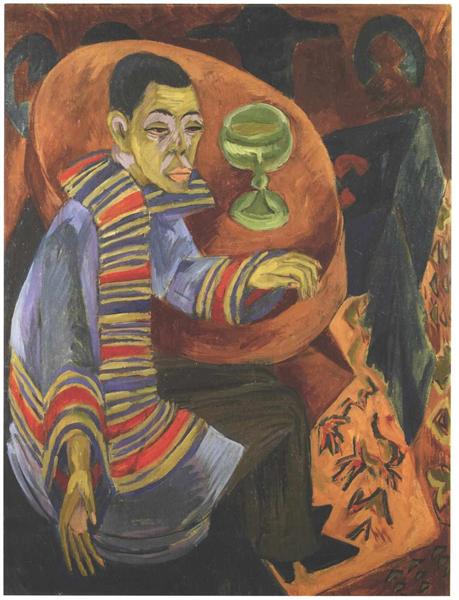Description
The painting "The Drink (Self -portrait)" by Ernst Ludwig Kirchner, made in 1910, is erected as a powerful visual testimony of the anguish and introspection of the artist, as well as the complexity of the human being in modernity. Kirchner, co -founder of the expressionist group Die Brücke, uses this work to explore not only his identity, but also the emotional tumult he experienced in a world in rapid transformation, marked by social changes and the imminent devastation of the First World War.
In the composition, Kirchner introduces himself in a moment of vulnerability, immortalized in a definite space, where vibrant colors and angular shapes combine to create a dense atmosphere and loaded with emotions. The background is built by an abstract space that frames its figure, which reinforces a feeling of isolation despite its proximity to the audience. The choice of color is significant; The dramatic tones of green, blue and red transmit an emotional intensity that defies the immediate perception of the viewer. The palette, typically expressionist, reflects not only an internal state of mood but also a rejection of the conventionality of academic art of its time.
Kirchner's face, deformed and sometimes distorted, stands out on the canvas. Its features, marked and expressive, reveal the internal struggle and conflict with their surroundings. His eyes, broad and fixed, seem to look for something beyond the viewer, as if they wanted to communicate an existential despair. The anemia and paleness of your skin contrast with the exuberance of the background and the drink that sustains, suggesting a fight with vices and addictions. This element could be interpreted as a symbol of escapism, an attempt to cope with the alienation of the modern being.
In addition, in the paint there is a glass of liquor that sustains firmly, which may well symbolize both personal consumption and the search for a lost sense or connection. This duality in the representation of the act of drinking resonates with a sense of self -pity, but also of evasion. Kirchner, like many of his contemporaries, was caught in the vertigo of the vibrant but often desolate realities of urban life, loneliness and the frantic rhythm of existentialism.
The way in which the work is culminates in a mixture of autobiography and social comment, a conductive thread in Kirchner's work. As the expressionist movement gained ground, artists began to dissolve the borders between art and life, focusing on their personal experiences and the dynamics of human existence. In this context, "the drinker (self -portrait)" can be interpreted not only as a reflection of the artist's internal struggle, but also as a criticism of the alienation of the individual in modern society.
Kirchner's exploration in this work can be seen as the culmination of his search for an aesthetic authenticity that will resonate with the deepest human experience. Through its characteristic style and its aguerrida technique, it manages to capture an intimate moment, transforming it into a universal story. With each line, the work not only tells a personal story, but becomes a microcosm of human experience, an invitation to reflection on loneliness, vice and the search for connection in an era of uncertainty.
KUADROS ©, a famous paint on your wall.
Hand-made oil painting reproductions, with the quality of professional artists and the distinctive seal of KUADROS ©.
Art reproduction service with satisfaction guarantee. If you are not completely satisfied with the replica of your painting, we refund your money 100%.

